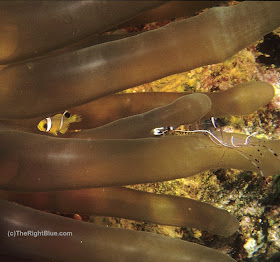BNSullivan.jpg) Here is an interesting little critter: the Anemone Shrimp (Periclimenes longicarpus), which is endemic to the Red Sea and the Arabian Sea. This shrimp lives commensally among the tentacles of certain anemones. The anemones' tentacles have stinging cells, called nematocysts, which most potential predators of the shrimp cannot tolerate, thus the shrimp's choice of home affords it some protection from predation.
Here is an interesting little critter: the Anemone Shrimp (Periclimenes longicarpus), which is endemic to the Red Sea and the Arabian Sea. This shrimp lives commensally among the tentacles of certain anemones. The anemones' tentacles have stinging cells, called nematocysts, which most potential predators of the shrimp cannot tolerate, thus the shrimp's choice of home affords it some protection from predation.Like many other shrimps of its genus, this Anemone Shrimp makes its living as a cleaner, in a manner similar to the little cleaner fish that we discussed last year.
This nearly transparent shrimp is very tiny. Its body is barely 2 cm (3/4 inch) long from its rostrum (i.e., snout) to the end of its tail. Its body has a pale lavender tinge to it, and its appendages and tail are marked with violet spots, and edged in white.
We think this shrimp is quite good-looking. It is a great subject for macro photography, although its very small size and transparency can make it difficult to find, unless you know where to look. We have seen them most often in two species of anemone: the Bubble Tip Anemone (Entamacea quadricolor), and the Sun Anemone (Gyrostoma helianthus). The trick is to learn to identify these anemone species so you can spot them, then look closely to see if there are any Anemone Shrimps among the tentacles.
BNSullivan.jpg) In the Red Sea, these Anemone Shrimp very often share their quarters with the Two-bar Anemonefish (Amphiprion bicinctus) -- AKA Red Sea Clownfish. The photo at left shows a juvenile Two-bar Anemonefish as well as an Anemone Shrimp. Note that the baby fish is even smaller than the shrimp!
In the Red Sea, these Anemone Shrimp very often share their quarters with the Two-bar Anemonefish (Amphiprion bicinctus) -- AKA Red Sea Clownfish. The photo at left shows a juvenile Two-bar Anemonefish as well as an Anemone Shrimp. Note that the baby fish is even smaller than the shrimp!For those interested in taxonomy, this Anemone Shrimp belongs to the family Palaemonidae. The family is relatively large, and is divided into two sub-families. The Periclimenes genus, of which this shrimp is a member, belongs to the sub-family Pontoniinae, characterized by their short, flattened rostrums. Most of the shrimps in this taxonomic group are known to live commensally with other invertebrates.
I photographed the two individuals on this page in the Red Sea, at a place on the coast of Tiran Island called Khush Khasha. Both were living in the same anemone. You can click on either of the photos for a larger view.
He is really tiny - not the eating kind that's for sure!
ReplyDeleteVery cool relationship...And such a little guy. It is almost not surprising that so little is known about the creatures in the ocean.
ReplyDelete@ Kathy - You're right. These guys are way to small to make a meal for humans.
ReplyDelete@ ScienceGuy - You've raised a great point. We know very, very little about the majority of the creatures that live in the sea. In most cases, we know little beyond taxonomic classification, and even that is a bit muddy at times. Only the critters that are perceived to have direct economic importance to humans get studied really thoroughly.
Bobbie
Awesome. What an interesting little thing it is!
ReplyDelete@ 2Sweet - Yes, they really are interesting little critters.
ReplyDeleteBobbie
So beautiful, so delicately limbed and hued.
ReplyDeleteAt the same time, it's too bad he isn't the eating kind, as I imagine that see-through food must be less caloric than opaque food.
See-through food less caloric? Hmm, never thought about it that way. Could be...
ReplyDeleteBobbie
Do you know if the longicarpus is facultative or obligate? I'm thinking of doing a lab research project about the behavior of this species with and without the presence of bicinctus, but i'm not sure if the research would matter if the shrimp is fine on his own.
ReplyDeleteBy the way, thank you so much for the picture! It is the exact species of anemone and anemonefish that I work with!
Hi Lauren -
ReplyDeleteI'm afraid I do not know the answer to your question. Anecdotally, I can say that I have seen many instances of A. bicinctus without the shrimp present, but I do not recall seeing P. longicarpus without the fish present, too. Then again, these shrimps are so tiny and difficult to spot in the wild that it's entirely possible I just missed them.
Not much help to you, I guess... but I'm glad you liked the photos.
Good luck with your research.
Bobbie